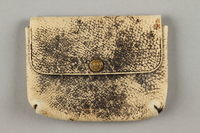Overview
- Brief Narrative
- Set of dog tags belonging to Ernest Kovary.
- Credit Line
- United States Holocaust Memorial Museum Collection, Gift of Myra Kovary and Vally Kovary.
Physical Details
- Classification
-
Military Insignia
- Category
-
Badges
- Object Type
-
Military dog tags (lcsh)
- Physical Description
- Set of two dog tags belonging to Ernest Kovary.
- Dimensions
- overall: Height: 2.500 inches (6.35 cm) | Width: 6.130 inches (15.57 cm)
- Materials
- overall : metal, metal, adhesive
Rights & Restrictions
- Conditions on Access
- No restrictions on access
- Conditions on Use
- No restrictions on use
Keywords & Subjects
Administrative Notes
- Legal Status
- Permanent Collection
- Provenance
- The collection was donated to the United States Holocaust Memorial Museum in 2009 by Myra and Vally Kovary, the daughters of Tom T. Kovary.
- Record last modified:
- 2023-08-31 15:04:05
- This page:
- https://collections.ushmm.org/search/catalog/irn714866
Download & Licensing
In-Person Research
- By Appointment
- Request 21 Days in Advance of Visit
- Plan a Research Visit
- Request to See This Object
Contact Us
Also in Kovary and Neuhaus families collection
The Kovary and Neuhaus families collection includes medals, ribbons, pins, a leather wallet, a leather portfolio, a set of silver ice cream spoons, and family papers documenting the Holocaust-era experiences of the Kovary family from Bratislava and the Neuhaus family from Hamburg.
Date: 1890-2013
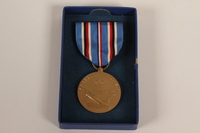
US Army American Campaign Medal and ribbon bar with presentation box awarded to a Czech Jewish refugee
Object
Bronze medal with ribbon, ribbon bar, and presentation box issued to Tom (Tibor) Kovary for service in the United States Army from 1943-1946. On September 2, 1939, 19 year old Tibor Kovari and his 20 year old brother, Erno, were attacked on the street for being Jewish by Nazi sympathizers in their hometown, Bratislava, Czechoslovakia. They fought back, put their attackers in the hospital, and were arrested, along with their father, Olivio. The incident received such widespread publicity that the authorities advised them to flee for fear of retaliation. They illegally crossed the border into Hungary, where they obtained visas for the US, arriving in New York on February 29, 1940. Both brothers joined the US Army: Tom was in Military Intelligence stateside; Ernest in combat, landing with the infantry on D-Day. He searched for surviving relatives, but found only one cousin, a survivor of Auschwitz death camp.
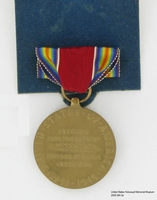
US Army Victory Medal, two ribbon bars and presentation box awarded to a Czech Jewish refugee
Object
Victory Medal, ribbon bars, and box issued to Tom (Tibor) Kovary for service in the United States Army from 1943-1946. On September 2, 1939, nineteen year old Tibor Kovari and his twenty year old brother, Erno, were attacked on the street for being Jewish by Nazi sympathizers in their hometown, Bratislava, Czechoslovakia. They fought back, put their attackers in the hospital, and were arrested, along with their father, Olivio. The incident received such widespread publicity that the authorities advised them to flee for fear of retaliation. They illegally crossed the border into Hungary, where they obtained visas for the US, arriving in New York on February 29, 1940. Both brothers joined the US Army: Tom was in Military Intelligence stateside; Ernest in combat, landing with the infantry on D-Day. He searched for surviving relatives, but found only one cousin, a survivor of Auschwitz death camp.
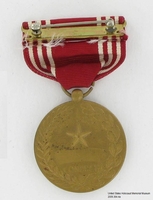
US Army Good Conduct Medal, 3 ribbon bars, and 3 ribbons awarded to a Czech Jewish refugee
Object
Good Conduct Medal, three red and white ribbon bars, and 3 replacement ribbons issued to Tom (Tibor) Kovary for service in the United States Army from 1943-1946. On September 2, 1939, 19 year old Tibor Kovari and his 20 year old brother, Erno, were attacked on the street for being Jewish by Nazi sympathizers in their hometown, Bratislava, Czechoslovakia (Slovakia). They fought back, put their attackers in the hospital, and were arrested, along with their father, Olivio. The incident received such widespread publicity that the authorities advised them to flee for fear of retaliation. They illegally crossed the border into Hungary, where they obtained visas for the US, arriving in New York on February 29, 1940. Both brothers joined the US Army: Tom was in Military Intelligence stateside; Ernest in combat, landing with the infantry on D-Day. He searched for surviving relatives, but found only one cousin, a survivor of Auschwitz death camp.

World Congress of Esperanto stickpin with an image of soldier upon a green star owned by a Czech Jewish refugee
Object
Commemorative pin from the World Congress of Esperanto in Vienna, Austria, in 1924, owned by Tom (Tibor) Kovary. On September 2, 1939, nineteen year old Tibor Kovari and his twenty year old brother, Erno, were attacked on the street for being Jewish by Nazi sympathizers in their hometown, Bratislava, Czechoslovakia. They fought back, put their attackers in the hospital, and were arrested, along with their father, Olivio. The incident received such widespread publicity that the authorities advised them to flee for fear of retaliation. They illegally crossed the border into Hungary, where they obtained visas for the US, arriving in New York on February 29, 1940. Both brothers joined the US Army: Tom was in Military Intelligence stateside; Ernest in combat, landing with the infantry on D-Day. He searched for surviving relatives, but found only one cousin, a survivor of Auschwitz death camp.

Bar Kochba Jewish Sports Club metal plaque with a Star of David owned by a Czech Jewish refugee
Object
Commemorative plaque from the Bar Kochba Jewish sports club awarded to Tom T. Kovary in Bratislava, Czechoslovakia, on January 9, 1938. On September 2, 1939, nineteen year old Tibor Kovari and his twenty year old brother, Erno, were attacked on the street for being Jewish by Nazi sympathizers in Bratislava. They fought back, put their attackers in the hospital, and were arrested, along with their father, Olivio. The incident received such widespread publicity that the authorities advised them to flee for fear of retaliation. They illegally crossed the border into Hungary, where they obtained visas for the US, arriving in New York on February 29, 1940. Both brothers joined the US Army: Tom was in Military Intelligence stateside; Ernest in combat, landing with the infantry on D-Day. He searched for surviving relatives, but found only one cousin, a survivor of Auschwitz death camp.

Bar Kochba Jewish Sports Club (BKB) stickpin with blue enamel decoration owned by a Czech Jewish refugee
Object
Pin from the Bar Kochba Jewish sports club (BKB) , in Bratislava, Czechoslovakia, received by Tom T. Kovary, prior to emigration. On September 2, 1939, nineteen year old Tibor Kovari and his twenty year old brother, Erno, were attacked on the street for being Jewish by Nazi sympathizers in Bratislava. They fought back, put their attackers in the hospital, and were arrested, along with their father, Olivio. The incident received such widespread publicity that the authorities advised them to flee for fear of retaliation. They illegally crossed the border into Hungary, where they obtained visas for the US, arriving in New York on February 29, 1940. Both brothers joined the US Army: Tom was in Military Intelligence stateside; Ernest in combat, landing with the infantry on D-Day. He searched for surviving relatives, but found only one cousin, a survivor of Auschwitz death camp.
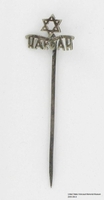
Hakoah Sports Club stickpin with a Star of David owned by a Czech Jewish refugee
Object
Pin from the Hakoah sports club that belonged to Tom T. Kovary, prior to emigration from Bratislava, Czechoslovakia. On September 2, 1939, nineteen year old Tibor Kovari and his 20 year old brother, Erno, were attacked on the street for being Jewish by some Nazi sympathizers in their hometown, Bratislava, Czechoslovakia. They fought back and put their attackers in the hospital and were arrested, along with their father, Olivio. The incident received such widespread publicity that the authorities advised them to flee for fear of retaliation. They illegally crossed the border into Hungary, where they obtained visas for the United States, arriving in New York on February 29, 1940. Both brothers joined the US Army during the war: Tom was in Military Intelligence stateside; Ernest in combat, landing with the infantry on D-Day. He searched for surviving relatives, but found only one cousin, a survivor of Auschwitz death camp.

US Army Good Conduct lapel button awarded to a Czech Jewish refugee
Object
Lapel button issued to Tom T. Kovary for service in the United States Army, from 1943-1946, during World War II. On September 2, 1939, nineteen year old Tibor Kovari and his twenty year old brother, Erno, were attacked on the street for being Jewish by Nazi sympathizers in their hometown, Bratislava, Czechoslovakia. They fought back, put their attackers in the hospital, and were arrested, along with their father, Olivio. The incident received such widespread publicity that the authorities advised them to flee for fear of retaliation. They illegally crossed the border into Hungary, where they obtained visas for the US, arriving in New York on February 29, 1940. Both brothers joined the US Army: Tom was in Military Intelligence stateside; Ernest in combat, landing with the infantry on D-Day. He searched for surviving relatives, but found only one cousin, a survivor of Auschwitz death camp.
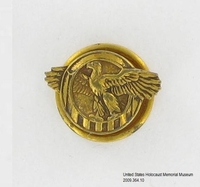
US Army Honorable Service lapel button awarded to a Czech Jewish refugee
Object
Lapel button issued to Tom T. Kovary for service in the United States Army, from 1943-1946, during World War II. On September 2, 1939, nineteen year old Tibor Kovari and his twenty year old brother, Erno, were attacked on the street for being Jewish by Nazi sympathizers in their hometown, Bratislava, Czechoslovakia. They fought back, put their attackers in the hospital, and were arrested, along with their father, Olivio. The incident received such widespread publicity that the authorities advised them to flee for fear of retaliation. They illegally crossed the border into Hungary, where they obtained visas for the US, arriving in New York on February 29, 1940. Both brothers joined the US Army: Tom was in Military Intelligence stateside; Ernest in combat, landing with the infantry on D-Day. He searched for surviving relatives, but found only one cousin, a survivor of Auschwitz death camp.

Bar Kochba Jewish Sports Club stickpin (BKB) with blue enamel decoration owned by a Czech Jewish refugee to the US
Object
Stickpin from the Bar Kochba Jewish sports club in Bratislava, Czechoslovakia, received by Tom (Tibor) Kovary, prior to his emigration to the United States. On September 2, 1939, nineteen year old Tibor Kovari and his twenty year old brother, Erno, were attacked on the street for being Jewish by Nazi sympathizers in Bratislava. They fought back, put their attackers in the hospital, and were arrested, along with their father, Olivio. The incident received such widespread publicity that the authorities advised them to flee for fear of retaliation. They illegally crossed the border into Hungary, where they obtained visas for the US, arriving in New York on February 29, 1940. Both brothers joined the US Army: Tom was in Military Intelligence stateside; Ernest in combat, landing with the infantry on D-Day. He searched for surviving relatives, but found only one cousin, a survivor of Auschwitz death camp.

World Congress of Esperanto medallion with an image of woman and a view of Budapest owned by a Czech Jewish refugee
Object
Commemorative medal from the World Congress of Esperanto in Budapest, Hungary, in 1929, attended by Tom (Tibor) Kovary with his family. On September 2, 1939, nineteen year old Tibor Kovari and his twenty year old brother, Erno, were attacked on the street for being Jewish by Nazi sympathizers in Bratislava. They fought back, put their attackers in the hospital, and were arrested, along with their father, Olivio. The incident received such widespread publicity that the authorities advised them to flee for fear of retaliation. They illegally crossed the border into Hungary, where they obtained visas for the US, arriving in New York on February 29, 1940. Both brothers joined the US Army: Tom was in Military Intelligence stateside; Ernest in combat, landing with the infantry on D-Day. He searched for surviving relatives, but found only one cousin, a survivor of Auschwitz death camp.
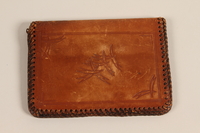
Brown leather wallet with laced edges used by a Czech Jewish refugee during his service in the US Army
Object
Wallet and passport cover used by Tom T. Kovary while a soldier in the United States Army from 1943-1946. On September 2, 1939, nineteen year old Tibor Kovari and his twenty year old brother, Erno, were attacked on the street for being Jewish by Nazi sympathizers in Bratislava. They fought back, put their attackers in the hospital, and were arrested, along with their father, Olivio. The incident received such widespread publicity that the authorities advised them to flee for fear of retaliation. They illegally crossed the border into Hungary, where they obtained visas for the US, arriving in New York on February 29, 1940. Both brothers joined the US Army: Tom was in Military Intelligence stateside; Ernest in combat, landing with the infantry on D-Day. He searched for surviving relatives, but found only one cousin, a survivor of Auschwitz death camp.

Red leather portfolio used by a Czech Jewish refugee
Object
Red leather notebook that belonged to Tom (Tibor) Kovary. On September 2, 1939, nineteen year old Tibor Kovari and his twenty year old brother, Erno, were attacked on the street for being Jewish by Nazi sympathizers in their hometown, Bratislava, Czechoslovakia (Slovakia). They fought back, put their attackers in the hospital, and were arrested, along with their father, Olivio. The incident received such widespread publicity that the authorities advised them to flee for fear of retaliation. They illegally crossed the border into Hungary, where they obtained visas for the US, arriving in New York on February 29, 1940. Both brothers joined the US Army: Tom was in Military Intelligence stateside; Ernest in combat, landing with the infantry on D-Day. He searched for surviving relatives, but found only one cousin, a survivor of Auschwitz death camp.
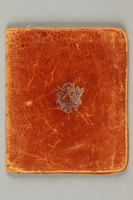
Document holder
Object
Brown leather bifold document holder with plastic covers inside. The wallet may have contained an ID card from the Office of Military Government for Germany (U.S) issued on 9 March 1946 to Ernest Kovary.
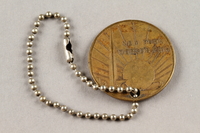
Social Security identification tag
Object
Round metal Social Security tag belonging to Ernest Kovary. The opposite side has an image of the New York World's Fair.
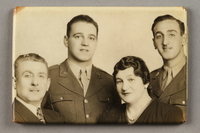
Pocket mirror with photographic image
Object
Pocket mirror with a photographic image of the Kovary family ca. 1945 on the other side.
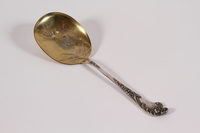
Silver ice cream serving spoon with floral engraving saved by young German Jewish refugee
Object
Silver ice cream spoon from a set of twelve brought by Ingrid Neuhaus, 18, when she was sent for safety from Hamburg, Germany, to Great Britain in Feburary 1939. She joined her younger siblings Annelore and Hans who had been sent on the Kindertransport in January. This set of spoons was the only valuable item she was able to take out of Germany.
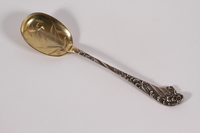
Silver ice cream spoon with floral engraving saved by young German Jewish refugee
Object
Silver ice cream spoon from a set of twelve brought by Ingrid Neuhaus, 18, when she was sent for safety from Hamburg, Germany, to Great Britain in Feburary 1939. She joined her younger siblings Annelore and Hans who had been sent on the Kindertransport in January. This set of spoons was the only valuable item she was able to take out of Germany.

Silver ice cream spoon with floral engraving saved by young German Jewish refugee
Object
Silver ice cream spoon from a set of twelve brought by Ingrid Neuhaus, 18, when she was sent for safety from Hamburg, Germany, to Great Britain in Feburary 1939. She joined her younger siblings Annelore and Hans who had been sent on the Kindertransport in January. This set of spoons was the only valuable item she was able to take out of Germany.
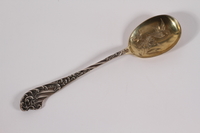
Silver ice cream spoon with floral engraving saved by young German Jewish refugee
Object
Silver ice cream spoon from a set of twelve brought by Ingrid Neuhaus, 18, when she was sent for safety from Hamburg, Germany, to Great Britain in Feburary 1939. She joined her younger siblings Annelore and Hans who had ben sent the Kindertransport in January. This set of spoons was the only valuable item she was able to take out of Germany.
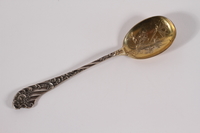
Silver ice cream spoon with floral engraving saved by young German Jewish refugee
Object
Silver ice cream spoon from a set of twelve brought by Ingrid Neuhaus, 18, when she was sent for safety from Hamburg, Germany, to Great Britain in Feburary 1939. She joined her younger siblings Annelore and Hans who had been sent on the Kindertransport in January. This set of spoons was the only valuable item she was able to take out of Germany.

Silver ice cream spoon with floral engraving saved by young German Jewish refugee
Object
Silver ice cream spoon from a set of twelve brought by Ingrid Neuhaus, 18, when she was sent for safety from Hamburg, Germany, to Great Britain in Feburary 1939. She joined her younger siblings Annelore and Hans who had been sent on the Kindertransport in January. This set of spoons was the only valuable item she was able to take out of Germany.
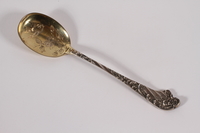
Silver ice cream spoon with floral engraving saved by young German Jewish refugee
Object
Silver ice cream spoon from a set of twelve brought by Ingrid Neuhaus, 18, when she was sent for safety from Hamburg, Germany, to Great Britain in Feburary 1939. She joined her younger siblings Annelore and Hans who had been sent on the Kindertransport in January. This set of spoons was the only valuable item she was able to take out of Germany.

Silver ice cream spoon with floral engraving saved by young German Jewish refugee
Object
Silver ice cream spoon from a set of twelve brought by Ingrid Neuhaus, 18, when she was sent for safety from Hamburg, Germany, to Great Britain in Feburary 1939. She joined her younger siblings Annelore and Hans who had been sent on the Kindertransport in January. This set of spoons was the only valuable item she was able to take out of Germany.

Silver ice cream spoon with floral engraving saved by young German Jewish refugee
Object
Silver ice cream spoon from a set of twelve brought by Ingrid Neuhaus, 18, when she was sent for safety from Hamburg, Germany, to Great Britain in Feburary 1939. She joined her younger siblings Annelore and Hans who had been sent on the Kindertransport in January. This set of spoons was the only valuable item she was able to take out of Germany.
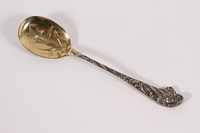
Silver ice cream spoon with floral engraving saved by young German Jewish refugee
Object
Silver ice cream spoon from a set of twelve brought by Ingrid Neuhaus, 18, when she was sent for safety from Hamburg, Germany, to Great Britain in Feburary 1939. She joined her younger siblings Annelore and Hans who had been sent on the Kindertransport in January. This set of spoons was the only valuable item she was able to take out of Germany.

Silver ice cream spoon with floral engraving saved by young German Jewish refugee
Object
Silver ice cream spoon from a set of twelve brought by Ingrid Neuhaus, 18, when she was sent for safety from Hamburg, Germany, to Great Britain in Feburary 1939. She joined her younger siblings Annelore and Hans who had been sent on the Kindertransport in January. This set of spoons was the only valuable item she was able to take out of Germany.

Silver ice cream spoon with floral engraving saved by young German Jewish refugee
Object
Silver ice cream spoon from a set of twelve brought by Ingrid Neuhaus, 18, when she was sent for safety from Hamburg, Germany, to Great Britain in Feburary 1939. She joined her younger siblings Annelore and Hans who had been sent on the Kindertransport in January. This set of spoons was the only valuable item she was able to take out of Germany.

Silver ice cream spoon with floral engraving saved by young German Jewish refugee
Object
Silver ice cream spoon from a set of twelve brought by Ingrid Neuhaus, 18, when she was sent for safety from Hamburg, Germany, to Great Britain in Feburary 1939. She joined her younger siblings Annelore and Hans who had been sent on the Kindertransport in January. This set of spoons was the only valuable item she was able to take out of Germany.
Kovary and Neuhaus families papers
Document
The Kovary and Neuhaus families papers consist of biographical materials, correspondence, and photographs related to the experiences of the Kovary and Neuhaus families’ pre-World War II experiences in Czechoslovakia and Germany, respectively; their emigration due to antisemitic persecution; their immigration to the United States and Great Britain; and subsequent experiences during World War II and in the immediate post-war years. The collection also includes restitution files documenting Ernest Kovary’s work assisting Holocaust survivors in filing restitution claims. Neuhaus family materials include biographical materials, correspondence, and photographs. Biographical materials document Ingrid’s immigration to Great Britain on a Kindertransport in 1939 and include her wartime diaries and a memoir she wrote in the 1990s. Correspondence files include Ingrid’s correspondence with her parents, who were killed in the Holocaust. This series also includes extensive pre-war, wartime, and post-war photographs of Ingrid Neuhaus Kovary and her family. Kovary family materials include biographical materials, correspondence, photographs, and printed materials documenting the Kovary family before, during, and after World War II. Biographical materials include birth, marriage, and death certificates; immigration documents; and documents pertaining to Olivio Kovary's repeated attempts to certify his American citizenship. Family correspondence primarily dates from the World War II years and includes many letters written in Esperanto. Photographs depict much of the Kovary family. Printed materials document the family’s interest in Esperanto. Restitution files include correspondence, forms, and notes documenting Ernest Kovary’s work as a notary public assisting Holocaust survivors in filing restitution claims.

